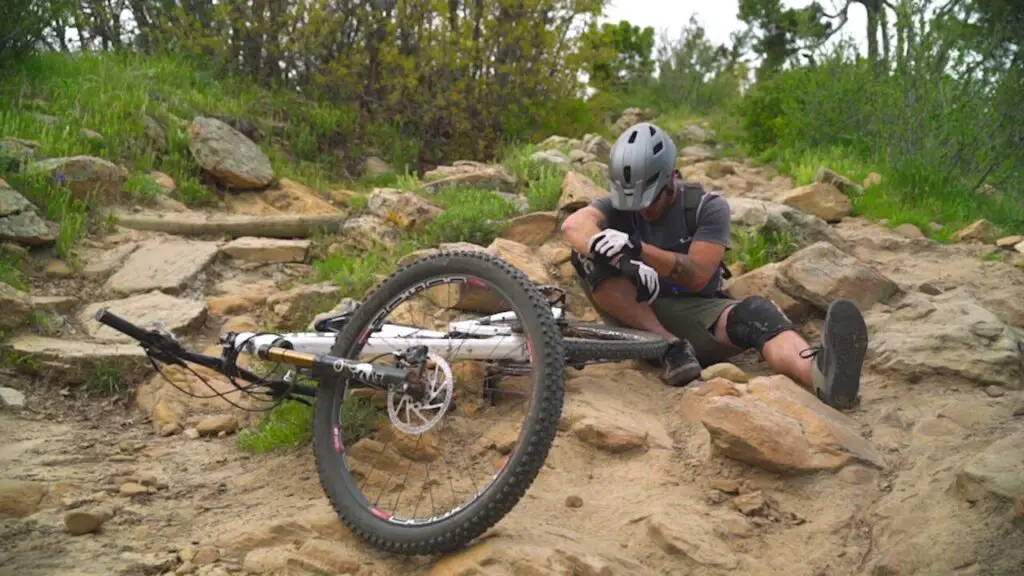
Mountain biking is often perceived as an extreme and hazardous activity by the general public. As an avid researcher, I was intrigued to investigate its safety records and compare them with other sports. The results of my analysis might astound you.
To begin with, mountain biking proves to be less perilous than most other sports. Contrary to popular belief, it causes fewer injuries than sports like football and baseball. Although mountain biking has more injuries compared to activities like roller skating, the difference is significant.
Table of Contents
How does mountain biking’s level of danger compare to that of other sports?
Before commencing this article, I must admit that I was unaware of the actual injury rates and statistics associated with mountain biking. This led me to ponder: How risky is mountain biking, and is it a hazardous sport?
To dive right into it, I present to you a graph displaying the reported injury rates per 1000 exposures for numerous sports. It’s worth noting that the term “exposures” means per event or per hour, with per hour being the more commonly used measurement.

It’s important to mention that the graph doesn’t include Bull Riding and Ice Hockey, which have injury rates of 119 and 32.2, respectively. These two sports are inherently dangerous and would overshadow the others in the graph, making it difficult to compare them to mountain biking.
Although the graph only displays the frequency of reported injuries, we cannot ignore the injury rates. The statistics reveal that a person is nearly ten times more likely to sustain injuries playing basketball than mountain biking. However, it’s important to note that mountain biking injuries may be more severe, such as shoulder damage or concussions, compared to relatively minor injuries like a broken finger in other sports.
On the other hand, Rugby is both high in frequency and severity of injuries, making it a more dangerous sport overall.
Overall, the statistics reveal that mountain biking has a lower rate of incidence when compared to several other popular sports. Therefore, it can be concluded that mountain biking is not as dangerous as most of these activities. This realization was unexpected, as the general perception of mountain biking is often associated with high risk and danger.
It’s essential to keep in mind that taking precautions and wearing proper safety equipment, especially a reliable helmet, is crucial to ensure a safe and enjoyable experience while mountain biking.
It’s worth noting that the reported numbers for mountain biking, 1.54 incidents per 1000 hours, includes both daytime and nighttime biking. Nighttime mountain biking poses additional risks beyond the ones encountered during the day. However, due to fewer daylight hours in the winter months, night biking is a common practice.
The Potential Risks

It’s important to distinguish between the different types of cycling that are often grouped together in statistics. In the graph presented earlier, it’s worth noting that road biking has nearly double the injury rate of mountain biking. The primary reason for this is the presence of cars on the road, and when a cyclist collides with a car, the injuries sustained are usually severe, including head injuries.
Cross-country mountain biking falls between downhill mountain biking and road biking since riders take mild off-road trails and lesser-traveled roads like fire roads and dirt car trails.
However, in this article, we are specifically focusing on mountain biking, where approximately 70% of injuries are caused by human error.
The most common injuries that occur during mountain biking are a fractured forearm, fractured hand or wrist, fractured shoulder or clavicle, head trauma or concussion, and trauma to the face. However, it’s worth noting that the first three injuries are the most frequent.
The most common scenario for these injuries is hitting an obstacle with the front tire, causing the rider to go over the handlebars. Often, this occurs when the rider fails to clear a fallen log or encounters a similar obstruction. As the rider falls, they typically use their hands to try and stop themselves, resulting in fractures to the forearm, hand, or shoulder bone. Additionally, head injuries can occur when the rider makes contact with the ground.
Therefore, having a high-quality helmet is of utmost importance. A top-notch helmet can decrease the risk of head injuries by 39% and facial trauma by 28%. It’s crucial to invest in the best helmet possible to ensure maximum protection during mountain biking.
Chances of Severe Injury
Knowing the type of injury is crucial as it can make a significant difference in the injury rate. The most common injury type reported is fractures. In a recent study by WEM/Whistler, shoulder and clavicle breaks accounted for 27.6% of the breaks, followed by wrist fractures at 24.7%, hand and finger fractures at 11.1%, and serious spine and neck breaks at 5.2%. 22.9% of the injuries were concussions or brain injuries, while only 1.8% of people required medical care on a stretcher.
Breaking a bone is serious, but it can heal with time. In particular, the 5% of life-threatening spine and neck breaks is a statistic of significant interest. Abrasions are also fairly common, mostly on the lower legs, but riders typically do not seek medical care for them.
So, what causes these injuries? According to studies, riding errors account for 72% of the injuries, with bad trail conditions causing 31% of them. Although the study adds up to 103%, it means that getting the proper safety equipment and learning good riding techniques can significantly reduce the risk of injury.
Which Risks can be managed and how to prevent them?
The rider has control over some injury risks, as highlighted in the 72% statistic mentioned earlier, while others are beyond their control, such as unpredictable weather and trail conditions.
Therefore, let’s examine what the average mountain bike rider can do to avoid danger and ensure a safe ride on their mountain bike.
- Getting in shape: Mountain biking can be physically demanding, with every rock and bump taking a toll on the body. Therefore, being in peak physical condition is essential to deal with the rigors of the sport.
- Stretching before riding: Increasing flexibility can help riders endure the physical strain of mountain biking. Gyms offer classes such as cardio and yoga that can help with flexibility and endurance.
- Planning the route: It is crucial to plan the daily ride in advance, including the obstacles and terrain to expect, dangerous areas such as cliffs to watch out for, and the estimated ride duration. It is also helpful to know the rules of the mountain bike trails that most bikers follow to ensure everyone is on the same page and less likely to run into each other.
- Maintain your equipment: Regularly check that your brakes are functioning and adjusted, tires are properly inflated and free from major damage, and that there are no cracks in the frame. Checking all bolts to ensure everything is securely attached to the bike is also essential. Being prepared with a well-maintained bike can prevent mishaps and accidents.
- Wear proper safety equipment: Wearing a high-quality helmet is a necessity as it can reduce the risk of brain injury by 39%. Additionally, mountain biking gloves, shoes, and pads and armor for the elbows, knees, and shins can also mitigate danger and make for a safer ride.
- Adjust your bike for your style: Setting up your bike to match your riding style is important to avoid repetitive injuries like Tennis Elbow. Adjusting brake levers to ensure a proper grip on the handlebars is one example.
- Bring water on your ride: Staying hydrated, even in cooler conditions, is necessary for peak focus and to avoid mistakes due to tiredness. Since rider error accounts for 72% of injuries, carrying water bottles in your biking kit is essential.
- Learn riding techniques from experts: Taking courses from experts is a great way to learn proper techniques and avoid rookie mistakes. Learning from experienced instructors can help riders navigate trails safely and confidently.
Which Risks cannot be controlled?
It’s important to acknowledge that not all injury causes can be attributed to rider error. Mother nature can also play a role in accidents, accounting for 32% of injury causes.
For example, glare from the sun can temporarily impair your vision, making it difficult to see obstacles ahead. Wet conditions can also pose a challenge, causing tires to slip on rocks or other surfaces.
While some factors may be out of your control, being prepared is key to minimizing risks. By following the previous tips and being aware of potential environmental hazards, you can increase your chances of having a safe and enjoyable mountain biking experience.
Mitigate Risks the Best You Can
In essence, it is important to recognize that mountain biking involves some inherent risk, as with any sport. However, by taking necessary precautions and preparing yourself, you can mitigate some of these risks. It is crucial to have proper knowledge of the terrain and trail conditions, as well as your own skill level. As a beginner, it is important to start with easier trails and gradually work your way up to tougher obstacles.
Additionally, it is vital to pay attention while riding, focusing on the immediate 10 feet ahead to avoid flipping over obstacles. In situations where it is necessary, bailing out can be a better option than risking serious injury.
While some factors, such as weather and trail conditions, are out of your control, being prepared can help to mitigate these risks. Ultimately, mountain biking can be a highly rewarding and enjoyable activity, and many enthusiasts find that the risk is worth it.








